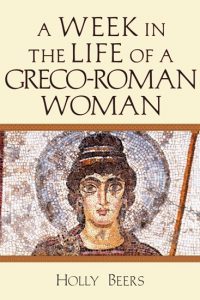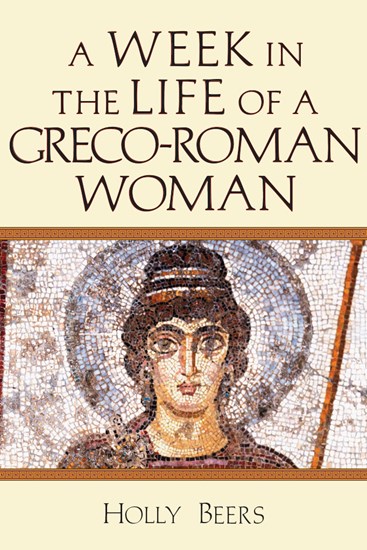Beers, Holly. A Week in the Life of a Greco-Roman Woman. Downers Grove, IL: IVP Academic, 2019, pp. 172, $17.00, paperback.
Dr. Holly Beers is Assistant Professor of Religious Studies at Westmont College, having previously taught at Bethel Seminary and North Central University. Beers is a Luke-Acts scholar, and earned her PhD in New Testament from the London School of Theology. Adding to her list of publications is the current book under review, A Week in the Life of a Greco-Roman Woman. This book is part of InterVarsity’s “A Week in the Life” historical-fiction series, which aims to illuminate the world of the New Testament. Other works in this series examine the week in the life of Corinth, the fall of Jerusalem, Rome, Ephesus, a slave, and a centurion.
Beers’ volume follows the daily life of a woman, Anthia, throughout one week of her life, with each of the seven chapters being told from the perspective of one day of the week. This creative work of historical-fiction reads like a captivating novel, as characters develop, interact with one another, and are exposed to Paul’s teaching about Jesus—who presents a challenge to the cultural worship of Artemis. Readers gain insights on what life was like for first-century women, as Beers highlights Anthia’s pregnancy, parenting, marriage, work, and social status. Beers also aptly shows what it would have been like for a community to hear the teaching of Jesus for the first time, and also how early followers of the Way would have interacted with one another across social barriers. The setting of the book is inspired by Acts 18-20 and 2 Corinthians 11-14.
One of the strengths of the book is its engaging format. Written as a novel, Beers draws the reader into Anthia’s life and thus exposes the reader to the way in which first-century Greco-Roman women experienced their world. To offer additional clarity, numerous descriptive sidebars provide specific information on a variety of topics. These topics include: abortion, infanticide, Artemis, marriage, poverty and subsistence, urban housing, sanitation, medicine and physicians, textiles, teeth, dyeing, cosmetics, laundry and fullers, perfumery, alcoholic beverages, honor and shame, the terrace houses, and patronage. The sidebars range from a brief paragraph to several pages, and occasionally include pictures. This format of a novel with brief clarification sidebars is both highly readable and also nicely informative.
Through this inviting format, Beers illuminates the world of the New Testament for her readers, showing how the first century would have been experienced by regular people. The reader learns of the dangers and fears surrounding pregnancy, the reality and regularity of spousal abuse, the daily fact of poverty and hunger, and the barriers of class difference and social structures. Along with learning about the daily life experienced by those in the era of the New Testament writings, the reader also gains insights into the ways in which early Christians operated. The reader is invited into the gatherings of the early church, and witnesses how they prayed, healed, read scripture, cast out demons, and cared for one another. Particularly helpful Beers’ description of how social barriers were broken in early Christianity. The wealthy violated societal expectations in their care for all people—rich and poor alike—as Christian brothers and sisters of all classes broke bread together, nurturing each other and the poor. This formation of a new family of followers of the Way challenged existing social structures and worship of local gods. The novel format of the book adds a slight touch of suspense, leading the reader to wonder how Anthia will respond to hearing the new teaching presented by Paul, and also whether or not Anthia’s husband will welcome the kindness of the Christian community.
The biblical and theological student should remember that this book is a novel—not an academic textbook. As such, the academic audience should feel the freedom to simply read and enjoy this book, while gleaning insights about first-century women and culture along the way. Students should enjoy the story-telling nature of the book, and the way in which it puts flesh to knowledge—remembering that women are real people, not merely topics to be studied. Though not an academic or technical book, this book is helpful for students of the New Testament to better understand the realities of how women experienced life in the Greco-Roman world. The academically-inclined reader will also be pleased by Beers’ useful bibliography of additional sources. This bibliography can point the reader who desires additional academic resources to further materials on the topics discussed in the book, including resources on Greco-Roman women, early Christian meetings, Artemis, and economic and social systems.
Overall, Holly Beers’ book A Week in the Life of a Greco-Roman Woman is highly recommended. The lay reader and academician will enjoy a leisurely Sunday afternoon read of this narrative, as Beers creatively weaves academic insights into this novel. This book will appeal to readers interested in the New Testament, in topics related to women, and the culture of the Greco-Roman world, along with readers who enjoy reading a good story.
Emily Buck
Fuller Theological Seminary





